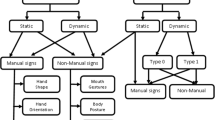Abstract
We present an intuitive, implicit, gesture based identification system suited for applications such as the user login to home multimedia services, with less strict security requirements. The term “implicit gesture” in this work refers to a natural physical hand manipulation of the control device performed by the user, who picks it up from its neutral motionless position or shakes it. For reference with other related systems, explicit and well defined identification gestures were used. Gestures were acquired by an accelerometer sensor equipped device in a form of the Nintendo WiiMote remote controller. A dynamic time warping method is used at the core of our gesture based identification system. To significantly increase the computational efficiency and temporal stability, the “super-gesture” concept was introduced, where acceleration features of multiple gestures are combined in only one super-gesture template per each user. User evaluation spanning over a period of 10 days and including 10 participants was conducted. User evaluation study results show that our algorithm ensures nearly 100 % recognition accuracy when using explicit identification signature gestures and between 88 % and 77 % recognition accuracy when the system needs to distinguish between 5 and 10 users, using the implicit “pick-up” gesture. Performance of the proposed system is comparable to the results of other related works when using explicit identification gestures, while showing that implicit gesture based identification is also possible and viable.







Similar content being viewed by others
References
Abate AF, Nappi M, Riccio D, Sabatino G (2007) 2D and 3D face recognition: a survey. Pattern Recognit Lett 28:1885–1906
Cho SJ, Oh JK, Bang WC, Chang W, Choi E, Jing Y, Cho J, Kim DY (2004) Magic wand: A Hand-Drawn Gesture Input Device in 3-D Space with Inertial Sensors. Proceedings of the 9th Int’l Workshop on Frontiers in Handwriting Recognition
Eurostat Average household size, http://appsso.eurostat.ec.europa.eu/nui/show.do?dataset=ilc_lvph01&lang=en
Guna J, Stojmenova E, Lugmayr A, Humar I, Pogačnik M (2012) User identification approach based on simple gestures, Proceedings of the 5th International Workshop on Semantic Ambient Media Experience (SAME) - in conjunction with Pervasive 2012 [Elektronski vir] : Newcastle, UK, 18th June 2012/[editors] Artur Lugmayr … [et al.]
Jain AK, Flynn P, Ross AA (2008) Handbook of Biometrics. Springer http://www.springer.com/computer/image+processing/book/978-0-387-71040-2
Jain AK, Ross A, Prabhakar S (2004) An introduction to biometric recognition. IEEE Trans Circ Syst Video Technol 14(1):4–20. doi:10.1109/TCSVT.2003.818349
Jun-qi K, Hui W, Guang-quan, Z (2009) Gesture recognition model based on 3D Accelerations. Proceedings of 2009 4th InternationalConference on Computer Science & Education
Kela J, Korpipää P, Mäntyjärvi J, Kallio S, Savino G, Jozzo L, Marca D (2006) Accelerometer-based gesture control for a design environment. Pers Ubiquit Comput 10:285–299
Keogh E, Pazzani M (2001) Derivative dynamic time warping. Proc. of the First Intl. SIAM Intl. Conf. on Data Mining, Chicago, Illinois
Liu J, Wang Z, Zhong L, Wickramasuriya J, Vasudevan V (2009) “uWave: Accelerometer-based Personalized Gesture Recognition and Its Applications”. Proc. IEEE Int. Conf. Pervasive Computing and Communication (PerCom)
Liu J, Zhong L, Wickramasuriya J, Vasudevan V (2009) User evaluation of lightweight user authentication with a single tri-axis accelerometer. Proc. ACM Int. Conf. Human Computer Interaction with Mobile Devices and Services (MobileHCI), September
Lugmayr A, Dorsch T, Humanes PR, Vallverdu J, ... (eds) (2009) Handbook of research on synthetic emotions and sociable robotics: new applications in affective computing and artificial intelligence, p 443-459. Information Science Reference, IGI Global, Hershey, New York
Maltoni D, Maio D, Jain A, Prabhakar S (2009) Handbook of fingerprint recognition. Springer professional computing, 2nd edn, XVI, p 496. 205 illus.. with DVD
Matsuo K, Okumura F, Hashimoto M, Sakazawa S, Hatori Y (2007) Arm swing identification method with template update for long term stability. Proc. Int. Biometrics
Montpetit MJ, Mirlacher T, Ketcham M (2010) IPTV: An end to end perspective. Journal Commun 5(5):358–373
Nabti M, Bouridane A (2008) An effective and fast iris recognition system based on a combined multiscale feature extraction technique. Pattern Recognit 41:868–879
Okumura F, Kubota A, Hatori Y, Matsuo K, Hashimoto M, Koike A (2006) A Study on biometric authentication based on arm sweep action with acceleration sensor. Proc. Int. Symp. Intelligent Signal Processing and Communications
Orozco M, Graydon M, Shirmohammadi S, El Saddik A (2008) Experiments in haptic-based authentication of humans. Multimed Tools Appl 37:73–92
Schlömer T, Poppinga B, Henze N, Boll S (2008) Gesture recognition with a Wii Controller. Proceedings of TEI, 11–14
Sedlar U, Zebec L, Bester J, Kos A (2008) Bringing click-to-dial functionality to IPTV users. IEEE Commun Mag 46:118–125
Toledano DT, Pozo RF, Trapote AH, Gómez LH (2006) Usability evaluation of multi-modal biometric verification systems. Interacti Comput 18:1101–1122
Varchol P, Levický D (2007) Using of hand geometry in biometric security systems. Radioengineering:16 (4):82–87
Varona J, Capó AJ, Gonzàlez J, Perales FJ (2009) Toward natural interaction through visual recognition of body gestures in real-time. Interact Comput 21:3–10
Volk M, Sterle J, Sedlar U, Kos A (2010) An approach to modeling and control of QoE in next generation networks. IEEE Commun Mag 48:126–135
Zaharis A, Martini A, Kikiras P, Stamoulis G (2010) User authentication method in implementation using a three-axis acceleoremeter. Mobile Lightweight Wireless Systems, Second International ICST Conference, MOBILIGHT, Springer
Zappi P, Milosevic B, Farella E, Benini L (2009) Hidden Markov Model based gesture recognition on low-cost, low-power tangible user interfaces. Entertain Comput 1:75–84
Acknowledgments
The operation that led to this paper is partially financed by the European Union, European Social Fund and the Slovenian research Agency, grant No. P2-0246. The authors also thank the participants who took part in the evaluation study.
Author information
Authors and Affiliations
Corresponding author
Rights and permissions
About this article
Cite this article
Guna, J., Stojmenova, E., Lugmayr, A. et al. User identification approach based on simple gestures. Multimed Tools Appl 71, 179–194 (2014). https://doi.org/10.1007/s11042-013-1635-1
Published:
Issue Date:
DOI: https://doi.org/10.1007/s11042-013-1635-1




